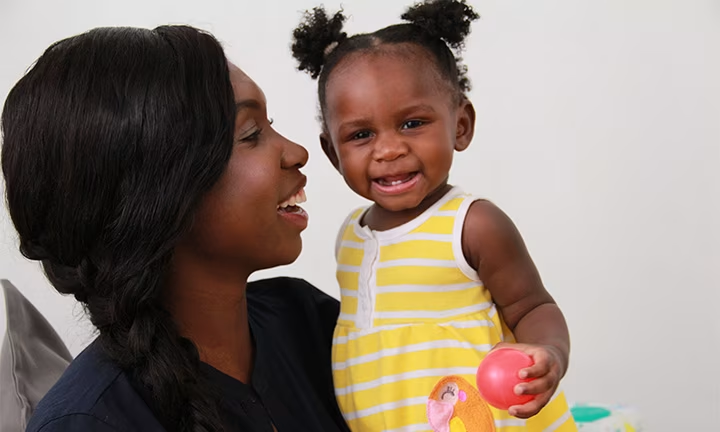
When Do Babies Start Teething? Your Baby’s Teething Timeline
Your baby’s first tooth is an exciting milestone, one of many you'll observe in the early months. Read on to find out when teething typically starts, which baby teeth tend to come in first, and when (and in which order) the rest of your little one’s baby teeth are likely to appear.
When Do Babies Start Teething?
Generally, teething can begin anywhere between the age of 3 and 12 months. However, in some very rare cases a baby may even be born with a tooth already erupted. Just as each child is an individual, teething timelines will vary from child to child. Your baby’s first tooth is likely to appear sometime around 6 months, although in some cases it could even take as long as 12 to 14 months for this to happen. Look out for signs of teething, such as tender gums, constant drooling or gnawing on a fist or finger.
How Many Baby Teeth Will Appear in Total?
Your baby’s first teeth are known as primary or milk teeth, and by around the age of 3 years he or she will probably have a full set of 20 teeth. When your child is around 5 or 6 years old, these milk teeth will eventually start falling out to make way for permanent adult teeth.
A Typical Teething Timeline
Growing teeth is not a competitive sport, and your baby’s teeth will arrive when they are ready. The timeline below is just a general guide, and children vary a lot in age when it comes to teething, so don’t be concerned if your friends’ children get teeth earlier or later than your baby does.
Teething Timeline
Caring for Your Teething Baby or Toddler
If you’re concerned about your baby showing discomfort because of teething there are plenty of things you can do to soothe teething symptoms. For example, give your little one a chilled teething ring to chew on or crunchy finger foods like breadsticks if your child is already eating solids. You could also ask your little one’s doctor or dentist for additional advice if you’re concerned about the discomfort your baby is in due to teething.
Reducing the Choking Risk
Remember that babies may attempt to chew even before they get their teeth but may not always fully chew their food before swallowing. This is why it’s always important to be mindful of choking risks and supervise your little one when he or she is eating. Even when children have a full set of teeth, but certainly before, certain foods present a choking hazard. Grapes and cherry tomatoes, for example, should always be quartered (long ways) before being served to babies or toddlers. Learn more about starting your baby on solid foods as he or she starts to sprout teeth.
Dental Care
It’s important to start taking care of your baby’s teeth as soon as the first one pokes through. Those teeth still have to last a good few years yet before they’re replaced with adult teeth and establishing good dental hygiene habits early will help set your little one up for lifelong healthy dental care habits. Use a tiny smear of baby toothpaste on a brush designed for your little one’s age. Brushing a baby’s first teeth can be tricky, but don’t worry if you don’t make a perfect job of it – the important thing at this stage is to get your little one used to the idea of regular brushing. Read more about looking after your baby’s teeth and going for regular dental check-ups.
Knocks and Bumps
Teething isn’t the only milestone your baby will be reaching around this time. As your toddler learns to crawl, stand and eventually walk and run, the chance of falls, knocks and bumps increases. There’s no need to wrap your child in cotton wool, but it’s a good idea to double check your home’s baby proofing to limit the chance of some easily avoidable accidents. One example is adding corner guards to low furniture, but there are plenty of things you can do around the home and outdoor areas to prevent some bumps and falls that can result in damage to your child’s teeth or mouth. Still, accidents can happen. If your toddler or child damages a tooth, stay calm and follow our advice on how to deal with some common tooth and gum injuries and other problems. If an accident has happened and you’re unsure what to do, contact your baby’s dentist or doctor for urgent advice.
FREQUENTLY ASKED QUESTIONS
Signs that your baby may be teething include:
- Tender, red gums where the tooth is coming through
- One red cheek
- Rubbing or pulling at an ear
- Drooling a lot
- Gnawing on fingers, hands or objects
- Fussiness.
The Bottom Line
If you’re still looking forward to seeing that first toothy grin, don’t worry. Some babies start cutting their teeth earlier and some later than others. If your baby is already teething, be patient: It can sometimes seem that just as the discomfort of one tooth breaking through is over, the next one starts to erupt. Knowing what a typical teething timeline looks like can help make the whole process more predictable and reassure you that your child’s teething woes won’t last forever. Take care of your baby’s new teeth and before you know it the gaps in your little one’s smile will be filled in with some of the cutest, whitest baby teeth you’ve ever seen!
Read more about Baby
Related Articles
Join Pampers Club and get:





